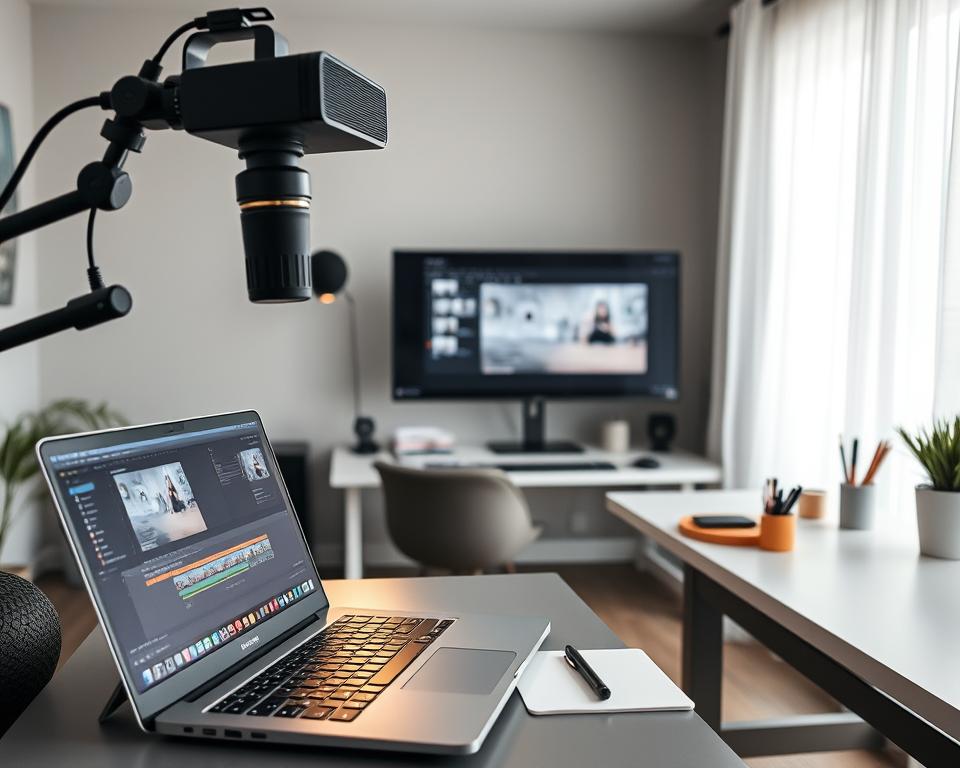
How to Create Engaging Training Videos for Your Company
Did you know employees are 75% more likely to watch training videos than read process documents? In today’s fast-paced work environments, training videos for your company have become a game-changer. Microsoft slashed L&D costs from $320 to just $17 per person by switching to video-based learning. With 97% of learners retaining information better through video, companies like WPP and Berlitz now use tools like Synthesia to produce thousands of micro-videos quickly. These stats show why video is now the go-to for onboarding, compliance, and upskilling.
Training videos for your company offer more than convenience—they cut costs, boost retention, and adapt to modern learning styles. Animated content can improve knowledge retention by 65%, while self-paced videos are preferred by 51% of employees. From Loom to Canva, tools now make creating professional content accessible even for small teams.
Key Takeaways
- Video-based learning cuts costs by up to 95% compared to in-person training.
- Animated videos boost retention up to 65% versus text-based materials.
- Microsoft saved $303 per employee using video training.
- Employees prefer self-paced video training over traditional methods.
- Tools like Synthesia let teams produce thousands of videos in weeks.
Why Training Videos Are Essential for Modern Companies

Corporate training videos are changing how companies teach their teams. They moved from in-person lectures to digital formats. This change fits the fast pace of today’s work world.
The Evolution of Corporate Learning
Old methods like manuals and seminars used to be the norm. Now, video-based learning is the go-to. Employees want easy, anytime access to learning. Video libraries offer this, and Microsoft saved 95% by switching to video.
Benefits of Video-Based Learning Over Traditional Methods
- Accessibility: Employees watch videos on desktops, tablets, or phones.
- Consistency: Key messages stay uniform across all viewers.
- Cost Efficiency: Reusable content reduces long-term expenses.
- Engagement: Visual storytelling captures attention better than text alone.
Statistics That Prove the Effectiveness of Visual Training
95% of viewers retain information from videos compared to 10% from text alone
Two-thirds of professionals watch instructional videos weekly (TechSmith, 2024). TechSmith Research Report). 2024). Nielsen Norman Group says video makes complex topics easier to understand. With 2.33 million mobile viewers (Statista), video meets remote work needs.
The Business Benefits of Investing in Training Videos for Your Company
Effective company training solutions help businesses grow by linking learning to their goals. By using video training, companies like Microsoft cut training costs from $320 to $17 per person. This shows how videos can be both affordable and effective for any size business.

Old methods need travel, venues, and materials. But video training gets rid of these costs. It lets teams learn whenever and wherever they want. Here’s why it’s a good choice:
- Cost savings: Businesses save 50–70% by not using in-person training.
- Flexibility: Employees can learn at their own pace without stopping work.
- Consistency: It ensures everyone gets the same message, no matter where they are.
| Traditional Training | Video Training |
|---|---|
| High costs for travel and venues | Lower costs with one-time production |
| Limited accessibility | Available 24/7 on any device |
| Hard to track progress | Analytics measure engagement and completion rates |
Video training also helps people remember more. They recall 65% of visual information compared to 10% of text. Companies like Microsoft use this to make onboarding faster and improve compliance. With options like animated or live-action videos, teams can make content fit their audience. Plus, modern platforms let you update training quickly, keeping it current.
Types of Corporate Training Videos That Drive Results
Companies around the world use various staff training videos to achieve their goals. Each type tackles different challenges, from welcoming new employees to improving leadership skills. These e-learning videos make complex topics easier to understand, improve retention, and foster a culture of ongoing learning.

Onboarding Videos for New Employees
Onboarding videos help new employees get settled in. IBM shows the “why” behind processes, not just the steps. Short videos about company values or tools can cut onboarding time by up to 50%.
Include team introductions and office policies to help new employees feel at home.
Skill Development and Technical Training
Technical training simplifies complex tasks. Microsoft saved $300 per employee with video tutorials. Use screen recordings, animations, or live demos to teach.
For example, software training can include step-by-step guides and quizzes to test understanding.
Compliance and Policy Videos
Compliance training can be hard to keep people engaged. Ernst & Young made email security relatable with a “dodgy deliveryman” story. LRN showed exaggerated consequences to stress risks, while Resonate used real lawsuits. These approaches reduced non-compliance by 30%.
Leadership and Professional Development
Leadership training makes managers better. The LDS Church used humor in safety videos. The Rapid Learning Institute explained science behind change to ease resistance. Short clips on conflict resolution or project management can be paired with role-playing exercises.
“Video learning increases retention from 25% to 60%.”
Choose formats like animated explainers or live-action scenarios based on your team’s needs. Whether it’s launching onboarding modules or compliance updates, tailored staff training videos make complex ideas easy to apply.
Planning Your Training Video Strategy
Effective training videos start with a clear plan. Begin by outlining goals using online training resources to align content with business outcomes. Avoid jumping straight into production—first, define what skills or knowledge employees need.

Set Measurable Learning Goals
Use Bloom’s Taxonomy to frame objectives like “employees will demonstrate software tools confidently” or “team members can resolve client issues within 5 minutes.” Specific goals ensure videos stay focused. For example, Zendesk’s onboarding videos use real scenarios to teach customer service skills effectively.
Research Audience Preferences
Survey teams to discover preferred formats—some may favor 2-minute microvideos while others need step-by-step tutorials. Blend formats like animated explainers for complex topics and role-play scenarios for soft skills. Remember: 73% of learners prefer video, but preferences vary by role and generation.
Build a Content Roadmap
- Use tools like Trello or Asana to schedule video releases
- Align topics with business priorities (e.g., compliance updates first)
- Include dates for revisions to keep content current
Sample templates from platforms like Articulate or LinkedIn Learning provide ready-made structures for online training resources. Regularly update the calendar to reflect new processes or software changes.
“A well-planned strategy turns training into a tool for growth, not just compliance.”
Essential Equipment and Software for Professional-Quality Videos
Making top-notch videos for your video training programs begins with the right tools. You don’t need to spend a lot to get great results. The right equipment makes your videos clear, professional, and engaging for learners.

- Entry-Level Basics: Begin with what you already have. Smartphones like the iPhone 13 can take sharp videos. Free tools like Screencast-O-Matic are great for screen recordings. Use a basic lavalier mic for clear dialogue and natural light from windows.
- Mid-Range Upgrades: Spend on a Sony FX6 camera for better lighting and a Sennheiser 8060 boom mic for clear audio. LED panels like Profoto B10 Plus add a professional touch. Camtasia’s Essentials plan ($179.88/year) edits tutorials with interactive features.
- Professional Suites: Adobe Premiere Pro and Final Cut Pro offer advanced editing. Vyond’s Premium tier ($89/month) creates animated content. High-end cameras like the Sony a7S3 and professional boom mics ensure top-notch quality.
For animation, Lumen5’s AI tools quickly turn text into videos. DaVinci Resolve’s voice isolation feature improves audio. Even a simple tripod or GorillaPod keeps shots steady. Free scripting tools like Celtx help draft scripts without breaking the bank.
Choosing the right mix of gear and software makes your video training programs shine. Focus on audio quality first—it’s more important than visuals. Use a mix of free and paid tools to balance your budget and quality. The right setup turns complex details into engaging, effective learning materials.
Crafting Compelling Scripts and Storyboards
Every great professional development video begins with a clear script and visual plan. Scripts make complex ideas easy to understand through stories. Storyboards show how visuals and audio will come together. Here’s how to make content that grabs attention:

Scriptwriting Tips for Maximum Impact
- Keep narration under 3-4 sentences per scene.
- Use templates or AI tools like Speechify Studio to draft quickly.
- Replace jargon with everyday language.
- Add questions or real-world scenarios to engage learners.
| Method | How to Use | Benefits |
|---|---|---|
| Template Scripts | Adapt existing video templates to your goals | Saves time and ensures structure |
| 3-Column Tables | Outline scenes, visuals, and narration side-by-side | Clarifies scene flow and timing |
| AI Tools | Use AI to generate first drafts, then refine | Speeds up brainstorming and iteration |
Storyboarding for Clarity
Sketch each scene with rough visuals, shot types, and voiceover notes. Even simple stick figures help plan transitions and ensure alignment between audio and visuals. Tools like Canva or digital boards simplify collaboration.
Psychology-Driven Design
Apply principles like the picture superiority effect—pair words with visuals for better recall. Place critical info at the start and end to combat attention drops. Use quizzes or branching scenarios in storyboards to boost retention.
Whether using templates or AI, every step should tie back to your team’s learning goals. A well-planned script and storyboard turn abstract concepts into memorable experiences for employees.
Production Techniques That Enhance Learning Retention
Good corporate training online starts with making content memorable. High-quality lighting and audio are key. A three-point lighting system makes sure faces and text are clear.
For audio, lapel mics and USB models like the Blue Yeti cut out background noise. This is important, even in busy workspaces.

- Lighting & Audio Basics: Place key lights above eye level, with fill lights to reduce shadows. Use foam windshields on mics to cut breath noises.
- Animation & Visuals: Animated infographics make compliance policies easy to understand. Tools like Camtasia help add animated text arrows to tutorials.
- Editing Mastery: Cut out long pauses and use B-roll clips of work settings to break up narration. Adobe Premiere’s speed ramps add visual interest without distracting.
Color grading tools in Final Cut Pro can make office footage feel welcoming. Post-production is more than just polishing. It’s about making videos that stick.
Platforms like Kaltura’s LMS integration let you add quizzes to videos. This boosts retention through active learning. Whether teaching safety or software, these methods keep your corporate training online sharp and effective.
Methods to Make Your Corporate Training Videos More Engaging
Creating training videos for your company doesn’t need to be funny or flashy. Begin by making each scene count. Start with a question like, “What if you could solve this problem in 5 minutes?” to grab viewers’ attention right away.
- Use real scenarios: Show how concepts apply to everyday tasks. For example, a customer service video could replay a common complaint call and model solutions.
- Incorporate brand voice: Match the tone to your company culture. A tech startup might use casual language, while a financial firm keeps it professional.
- Add interactive moments: Pause the video to ask viewers to solve a problem on screen, then reveal the answer. Tools like Articulate Rise 360 enable this without coding.
- Keep it visual: Use split-screen comparisons, animated process diagrams, or on-screen quizzes to break up narration.
“Engagement isn’t about entertainment—it’s about giving viewers a reason to care.”

Test videos with a small audience first. Ask, “Did this help you solve a real problem?” Use their feedback to simplify confusing sections or shorten lengthy explanations. Even short videos (under 3 minutes) work better when paired with post-viewing discussion forums or follow-up emails. By focusing on clarity, relevance, and practical takeaways, your training videos for your company become tools employees actually want to watch.
Distributing Your Training Videos Effectively Across Your Organization
Getting your training videos to every employee is key. Use tools like learning management systems (LMS) to align your employee training resources. With 80% of employees liking video learning, smart distribution boosts engagement and keeps knowledge fresh.

Learning Management Systems (LMS) Integration
- Link videos to your LMS with clear metadata tags for easy searchability.
- Set up progress tracking to monitor completion rates and identify gaps.
- Organize courses by role or department to personalize learning paths.
Mobile-Friendly Distribution Strategies
Make videos easy to watch anytime with these tips:
- Use adaptive streaming to ensure smooth playback on smartphones and tablets.
- Optimize lengths to 10 minutes or less for on-the-go viewing.
- Upload to platforms like The EmployeeApp for mobile notifications and analytics.
Security Considerations
Keep sensitive content safe with:
- Password-protected access for compliance or confidential topics.
- Digital rights management (DRM) to prevent unauthorized sharing.
- Regular audits of access logs and permissions.
Create a learning hub on your company’s website for easy access. Add clear descriptions and interactive quizzes to videos. Update your distribution channels based on how well they work to keep improving your strategy.
Measuring the Effectiveness of Your Video Training Programs
Tracking the success of corporate training videos needs a clear plan. Start by setting KPIs that match your training goals. For example, onboarding videos aim to cut down time-to-competency. Compliance training focuses on policy test scores.
| Kirkpatrick’s Levels | Key Metrics | Measurement Tools |
|---|---|---|
| Reaction | Post-view surveys, feedback ratings | Surveys like SurveyMonkey |
| Learning | Pre/post-test scores | Online assessment platforms |
| Behavior | Manager observations, peer reviews | Performance reviews |
| Impact | Productivity metrics, error reduction | Business analytics tools |
Use tools like Wistia or YouTube Analytics to track views and completion rates. Also, look at behavioral data like reduced support requests or better sales. A good practice is to:
- Align metrics with business objectives before production
- Conduct follow-up surveys 3–6 months post-training
- Compare pre- and post-training performance data
Remember, “Measurement isn’t just about numbers—it’s about stories that prove learning drives action,” says Jane Smith from Training Industry. Share reports that show cost savings from faster onboarding or fewer compliance violations. This justifies the investment in corporate training videos.
Conclusion: Transforming Your Company’s Learning Culture Through Video
Modern training solutions have changed how teams learn. Videos help us remember 95% of what we see, compared to 10% from text. Now, over 90% of professionals prefer learning through videos.
Using AI and AR makes training more personal and interactive. Videos save money by reducing the need for meetings. They also help everyone in the company stay on the same page.
Short videos keep learners interested, while longer ones cover complex topics. But, starting a video training program can be tough. You need to get your leaders on board.
Start small with a pilot project to build momentum. It takes 66 days for new habits to stick. Keep track of how well your training is working.
Companies that use video training see better productivity and lower costs. Start with one video and then grow your program. Video training is more than just content. It’s a way to make learning a part of your company’s culture.